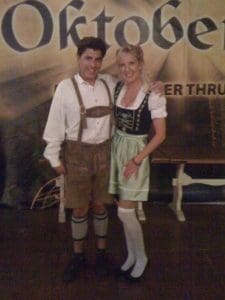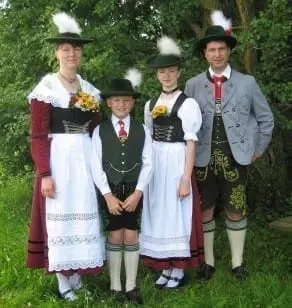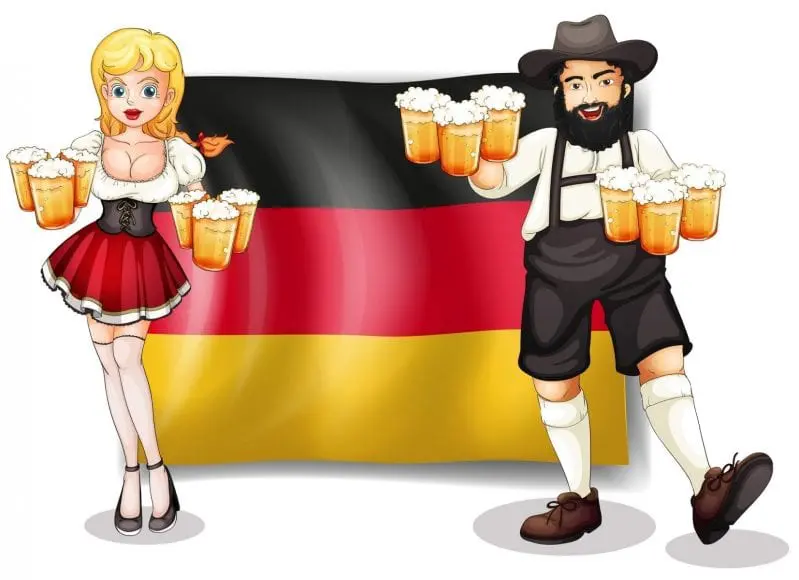
I’ve been thinking about stereotypes a lot lately… and what does a German look like? Whenever Germans are portrayed in advertising, or in festival invitations, they always seem to be wearing Lederhosen or Dirndls. But, as I’m reminded EVERY TIME I post such a photo, that is not how the typical German looks or dresses.
So, the question is… how should Germans be portrayed in around the world? How should Germans be identified?
What Does a German Look Like?
Should Germans be portrayed as blond haired and blue eyed? I know a lot of German Brunettes…
Maybe it’s the feathered hat? Honestly, both of my Opa’s wore hats, but no feathers…
What a German looks like is changing faster than ever. We are in a time of shifting population, but this is not new! Just look at the German National Fussball Bund… it’s a rainbow. The controversy they stirred up by putting the players on Kinder Schokolade was absurd. (read that here) And to me, skin and hair color are not as important as what’s in your heart…. or how you integrate yourself into German life. In Germany… children whose families came from Turkey or Syria or India speak the language, sing the songs, and are learn culture, the right alongside the other kids.
I remember a train ride I took in Berlin. There were a few girls who looked as though they probably had Middle Eastern ancestry, but they were chattering up a storm in GERMAN, and were giggling over the prizes they found in their Kinder Eggs. Like every other German kid.
Seriously… While at German Fest in Milwaukee, we spoke with one couple who said that they traced their roots back to Germany… and that their Great Great Great Grandparent had come to the US in the 1840s! And yet, they were at German Fest because they wanted to raise their daughter with German traditions. Does that make this family more German than the child whose family emigrated to Germany from Turkey three generations ago?
Personally, I the way I spot a German in a crowd? Their leather shoes and the ability to wear a scarf well. (Seriously… the scarf gene must be a German thing)
Dressing in “German” Tracht Is About Connection
So, is it wrong to associate Germans with Dirndls and Lederhosen? Are Americans being disrespectful to dress this way? What it comes down to is this: America is a land of immigrants. Some people have families that have arrived a few years ago, others have been for a few generations, and some people, their family may have immigrated even BEFORE Germany was unified from many states into one country back in 1870. One thing many people have in common is a desire to identify with family heritage. It gives them something to be a part of.

http://folkcostume.blogspot.com/
How do you connect with a place you’ve never been? Or a place you’ve visited once on a tour? Or maybe you were stationed there for a few years (And keep in mind, the American sector of Germany was Bavaria… so this is the image that was carried home to the US. Those Lederhosen and Dirndls… Bavarian).
If great-grandfather came from Germany, and wore his feathered hat and Lederhosen to the festival every year, and everyone else wears the same, why wouldn’t you?
I’ve never owned a dirndl when I was growing up… it’s not very traditional in the corner of North Rhine Westphalia where my family ended up. And I’ve never flown a German flag in my home; patriotism was not encouraged in my world. Does that make me less German? Would an American see it as a failure of my “German-ness”? Would a German care?
German Stereotypes


Now… certainly, many Germans in Germany despair over the misconception of how they are perceived worldwide. Honestly, this is typical stereotype of what a German looks like…Oompha Music loving, Big Beer Steins swaying, Lederhosen wearing, big boobs hanging out of dirndl tops…. Germans are the “Bad Guys” in many movies, generally you will see them as Nazis, but the worst was when seeing them in children’s movies (the Toy hating Burgermeister in ‘Santa Claus is Coming to Town’ or that creepy guy living in Neuschwanstein in ‘Chitty Chitty Bang Bang).…. These things no more universally German than blond hair. I know, because it’s bothered me too. “How can they do that?” “Does the world think we sit around all day drinking beer, eating bratwurst, and playing the accordion?” That image is as false as saying all Americans are fat, loud, and wear white tennis shoes.

Note the scarf….
But then, until I attended Germanfest, Milwaukee, I never wore a dirndl.
So let’s flip it. Does wearing Tracht make you MORE German?
Nope… but it gives some people a sense of connection.
(And the dirndl made for me by Erika at Rare Dirndl is cute!)
Dressing “German”
I’ve been to some German Festivals, and I see how very HAPPY people are. How much they enjoy connecting with their heritage. How much they enjoy being a part of a group, and to connect with an ideal of what it means to be German.
I know, and I’m sure most everyone knows that the average German does not walk around in festival gear. (At least I REALLY hope so). Germany is not some bizarre “Freilicht Museum” where people are cartoons. Just like you don’t see Mexican people walk around wearing Sombreros all the time, or Japanese people wearing Kimonos as daily wear.
Wearing “Tracht” to a festival connects people.
Time and progress will continue to change what a German looks like or dresses like, but the vision held by many Americans, the stereotype if that’s what you want to call it, probably won’t. People might always be a bit surprised to see an Asian kids speaking fluent German…and I admit, I made a stupid assumption when ordering in a Sushi restaurant in Münster.
Whichever you choose, I guarantee you, if you come to a German Festival in America, however you choose to dress, whatever color you are, whether or not you speak German, you will be welcomed… and someone will pull you a beer.
Prost!

LOVE IT
photo from the La Crosse Oktoberfest
There are MANY Styles of German Tracht
What does a German look like when they dress in Tracht? Depends on where they live in Germany… This book is an amazing look at many of the various styles worn by Germans through the years. It’s more than just a dirndl…
Traditional Couture: Folkloric Heritage Costumes



Just a note: I have been repeatedly told that Tracht is not a “costume”. I think it is mostly semantics, and the English language does not have a translation for the word Tracht, except for an approximate “folk costume”. Perhaps that is one reason so many Germans get offended. In the US and elsewhere the dirndl and lederhosen (the authentic tracht) is reduced to a fancy dress or halloween costume caricature. Tracht is not worn daily in modern Germany, but it is revered and kept for specific occasions. Not everyone nor even all Germans understand this sensitivity and the formality. Fashion is beginning to lean toward to a folk dress style. German clothing designs are current and gaining popularity even in the US. But tracht is not fashion. Fashion is influenced by tracht, but continues to progress and change. Tracht is fixed by history and tradition. There is etiquette, and meaning behind its use. The “costume” is humorous, and designed to inexpensively depict a silly stereotype.
So how do we express our Germaness outwardly? Since so many Americans have German ancestry, it may be just learning the difference and recognizing the authentic tracht and fashion dirndl from a “costume”. Taking pride in and rocking the real deal.
THanks Heidi, you are right, costume is the wrong word. Folk dress is much better.
Thanks for your comment. I thought ‘Tracht’ referred to the grey and green type of traditional dress, so I have learnt something too. I have seen elegant versions of the grey and grey traditional suits worn by both men and women many years ago.
It seems to me that only the Bavarian traditional dress is thought of as ‘German’ anywhere in the English speaking world. Most likely because there doesn’t seem to be any other traditional dress from Germany that is known ‘im Ausland’.
It would be good if other types of traditional dress were resurrected. The only other traditional dress I know of (as a foreigner) is the Black Forest one with the huge balls on the girls’ hats….must be others I imagine.
I’m from Hamburg. One of the largest seaports in the world. However, we don’t all wear sea captain’s hats either. This is a choice, usually made by those who work in the port or go to sea. For the most part they wear what’s comfortable and serviceable. By the same token, not all persons from Hamburg speak Plattdeutsch.
RE: Plattdeutsch — Of course not, Manfred, most speak Missingsch! 😉
Tracht refers to traditional garments in German-speaking countries. Although the word is most often associated with Bavarian and Austrian garments, many other peoples of Germany have them.
History
In northern Germany some of the best known examples are the “Friesische Tracht” and the Finkenwerder Tracht. The “Friesische Tracht” is richly decorated with beads and embroidery. The quality of the work was a sign of the riches and social status of the wives wearing it. In former times it was brought into a marriage by the bride as part of her dowry. This costume is occasionally still worn at weddings. The “Finkenwerder Tracht” is the traditional garment of the inhabitants of an island in the Elbe river. It is worn by a local folklore group called Finkwarder Speeldeel.
Visitors to the Black Forest region will be familiar with the wide brim hats decorated with big red pompons (known as Bollenhut) that are part of the Tracht in the three villages of Kirnbach, Gutach and Reichenbach.
Displaced German peoples like the Sudetendeutsche often used events where they wore Tracht to emphasize their unity.
Costumes worn by professional guilds, habits of religious orders, deaconesses and the historical garment of some occupational groups (e.g. nurses) are also called “Tracht”. While some of them have fallen into disuse, carpenter journeymen can still be seen wearing their traditional garment while traveling throughout Europe.
Originally, the word “Tracht” had a much wider meaning in German in the sense of “what is carried/worn/borne”, as it is connected to the verb “tragen”, meaning “to carry/wear/bear”. So “Tracht” can refer to the clothes which are worn, but e.g. also simply to a load, which is carried (still used by beekeepers, referring to the load of honey carried in by the bees), or within the German idiom “eine Tracht Prügel” (a load (of) beating) to “a good beating”.
I am from NRW, too. Some 58 years ago! Where do you come from? I am from the County (former Principality) of Wittgenstein (now Siegen-Wittgenstein).
My parents grew up near Muenster… in Buldern. Mom came from Silesia originally, and dad from Brandenberg.
Great points! Really thoughtful post that gave me a lot to consider and think about. Thanks for piecing together these ideas and thoughts. And congratulations on reaching 8000 likes on Facebook! woohoo!! Keep up the great work 🙂 Mit freundlichen Grüßen, Dana
Thanks so much! It’s been on my mind for a while.
I am from Berlin, obviously we are all German and no one in my family has ever worn a dirndl. So don’t generalize and say that this is what all German wear
I don’t… my family is from the Northern part of Germany… we don’t wear a dirndl.
Ein Dirndl und die Lederhose ist eine Sueddeutsche Dracht Baiern (Bavaria, Schwaben ,Austria,Switzerland!
Again and again I am amazed that German Trachten are predominantly depicted in southern Germany. Bavaria is only one federal state in Germany, there are 15 other federal states with very different costumes. We inhabitants in Cologne, for example, have no traditional costumes. But we have thousands of different costumes for carnival. But I’m certainly not telling you anything new with that, am I ? Herzliche Gruesse aus Koeln
Hello Matthias… no, not new stuff… as I wrote in the post, I never had a Dirndl until I was invited to German Fest and it was gently suggested that I wear one to fit in. My family is in NRW… I’m more familiar with Köln than München.
And yet… still German…
Part of my goal with this blog is to share the differences in Germany. How it’s not a cookie cutter place where everyone looks like an Oktoberfest Poster.